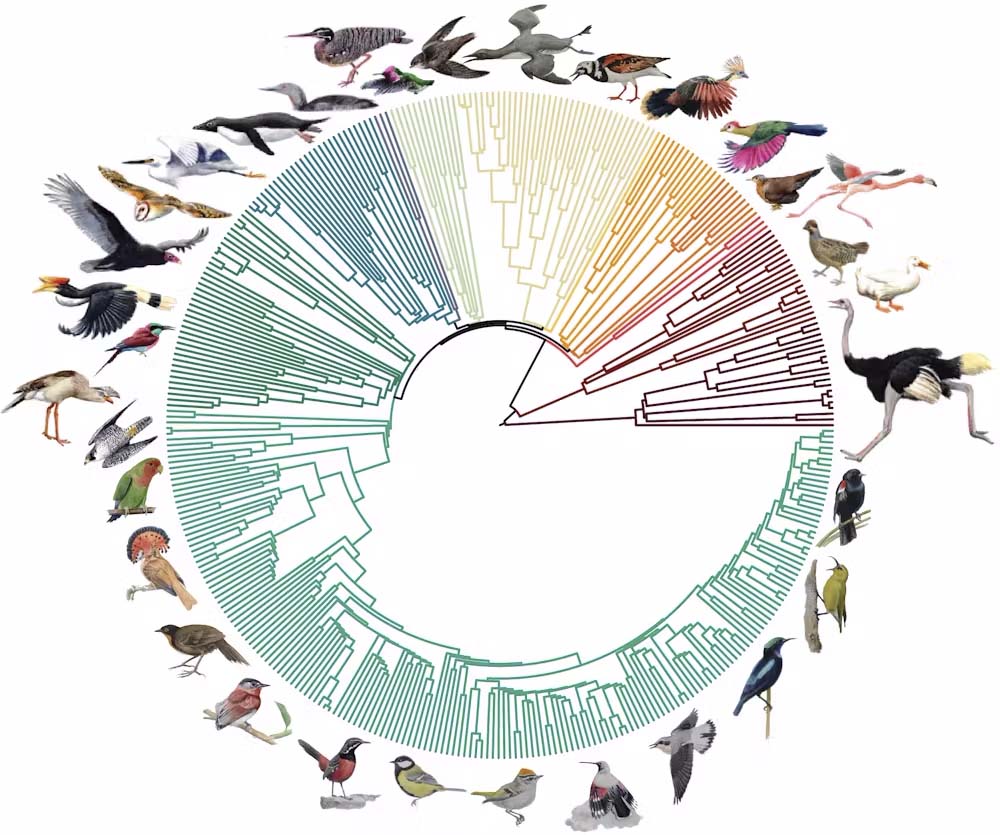The most comprehensive study of modern bird genomes to date has resulted in the reconstruction of the bird family tree, challenging conventional notions about the evolutionary trajectory of birds.
Published in the journal Nature, the decade-long study integrated genomic data from more than 360 species, with information from nearly 200 fossils. It is the work of collaborative research by scientists worldwide participating in the Bird 10,000 Genomes Project (B10K), aiming to sequence the complete genomes of every existing bird species.
Lead author Josefin Stiller, a biologist at the University of Copenhagen in Denmark, said: "Our study has addressed previous controversies regarding the bird family tree and has added new insights to the established understanding of bird evolution."

The 'bird tree of life', based on the genomes of 363 species. The major bird groups are colour-coded (Jon Fjeldså, Natural History Museum Denmark).
Three major clades
Among the roughly 10,000 living bird species, three major clades are identified. Approximately 5% of species belong to either Palaeognathae, encompassing flightless species such as ostriches, cassowaries, and emus, or Galloanseres, including landfowl and waterfowl. The remaining 95% of bird species constitute a third diverse clade: the Neoaves.
The study suggests that most Neoaves emerged within a relatively short evolutionary timeframe of only 5 million years, following the rapid diversification period after the Cretaceous-Paleogene extinction event 66 million years ago.
Dr Jacqueline Nguyen, avian palaeontologist at the Australian Museum and Flinders University and co-author of the study, commented: "By analysing evidence from nearly 200 bird fossils, we identified a crucial period of bird diversification immediately following the dinosaur extinction event."
During this period, significant genetic and morphological changes occurred among birds, including heightened mutation rates, reduced body sizes, larger brains, and increased effective population sizes.

Relationships for 363 bird species (Josefin Stiller).
Revolutionising views on avian history
The findings offer scientists a clearer understanding of the bird family tree, particularly within the Neoaves. The revised tree challenges previous classifications of Neoaves by reorganizing it into four major sub-groups: Mirandornithes, Columbaves, Telluraves, and a newly proposed group named 'Elementaves' by the researchers.
Inspired by the elements of earth, air, water, and fire, Elementaves includes birds that thrive on land, in the air and in water, such as penguins, pelicans, hummingbirds and shorebirds.
Guojie Zhang, senior author of the paper and professor of evolutionary biology at Zhejiang University, China, said: "Our research has revolutionised many conventional views on the evolutionary history of birds. This updated family tree will serve as a robust framework for tracing the evolutionary history of all bird species, with significant implications for ornithological research and biodiversity studies."
Reference
Chowdhury, A A, Feng, S, Stiller, J, et al. 2024. Complexity of avian evolution revealed by family-level genomes. Nature. DOI: doi.org/10.1038/s41586-024-07323-1

